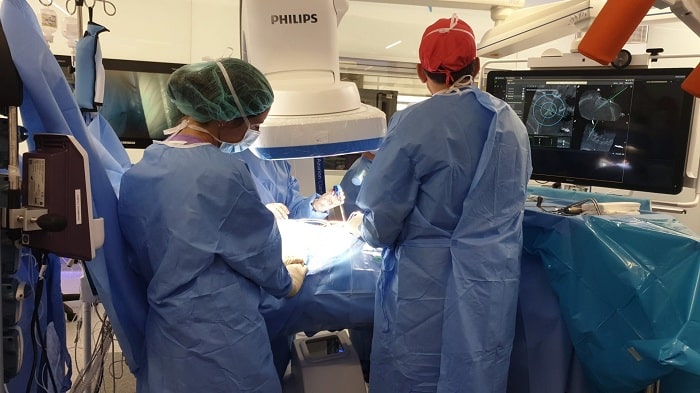Royal Philips, a global leader in health technology, announced that the first patients have been successfully treated using its innovative 3D Augmented Reality (AR) spine navigation solution at Sant Joan de Déu Barcelona Children’s Hospital, Spain, and the Armed Forces Hospital, Oman. For both cases the surgeons used Philips integrated Spine Suite solution that offers the company’s Azurion Hybrid Operating Room (OR) with ClarifEye, an industry-first solution that combines 2D and 3D visualisations at low X-ray dose with 3D AR navigation into one system. This enables surgeons to define and navigate along the critical pathway using this advanced real-time image guidance for precise device placement both in open and minimally invasive spine procedures*.
The first patient treated with ClarifEye at Sant Joan de Déu Barcelona Children’s Hospital involved open image guided surgery on a 12-year-old patient with severe congenital spondylolisthesis, a condition where the spine is misaligned due to a defect in one of the joints. Without treatment, it can affect quality of life and increase the risk of several chronic conditions. Using the Philips’ spine solution, pedicle screws were successfully placed at four spine levels to fuse several lumbar vertebras. “The level of success of this surgery would not have been possible to reach without ClarifEye,” said Dr. Alejandro Peiró, Orthopedic surgeon and pediatric traumatologist at Sant Joan de Déu Barcelona Children’s Hospital.
Head of Department Orthopedics and Spine Surgery at Hospital MoD, Oman
At the Armed Forces Hospital in Muscat, Oman, an adult 51-year-old patient with multi-level degenerative lumbar stenosis, a narrowing of the spinal canal in the lower part of the back, was successfully treated using minimally invasive techniques. “Philips’ new technology enables us to perform less invasive procedures and produce better outcomes for patients with spine conditions,” said Dr. Ahmed Al Jahwari, Head of Department Orthopedics and Spine Surgery at Hospital MoD, Oman. “Thanks to the high quality of the intraoperative cone beam CT imaging and the positioning flexibility of the ClarifEye system, we can ensure that implants are in place which lowers post-operative CT scans to check implant placements.”
Increased clinical accuracy and improved outcomes
Treatment for spine conditions can often be complex and delicate. Surgeons need to take particular care to avoid fragile neurological and vascular structures close to the spine. Such procedures have traditionally been an ‘open surgery’, where surgeons would manually manipulate the patient’s spine to position implants such as pedicle screws. As technology has advanced, there has been a shift to using minimally invasive techniques, such as small incisions in the patient’s skin, minimizing blood loss and soft tissue damage and consequently reducing postoperative pain. In both approaches, surgeons can now use the real-time imaging and 3D navigation of ClarifEye. Intra-operative image guidance increases clinical accuracy and improves outcomes, with patients subject to fewer revision surgeries compared to the previous standard of care [1,2]. Data published in Science Reports demonstrated that ClarifEye performed better in accuracy than open surgery pedicle screw placement without 3D navigation (94% vs 89,6%) [3]. In addition, data from a clinical study using ClarifEye, showed a 98% accuracy of pedicle screw placement during minimally invasive procedures [4].
Growing international adoption
ClarifEye Augmented Reality Surgical Navigation was introduced earlier this year. The sites in Spain and Oman complement the growing international ecosystem of innovation partners that have adopted this new solution such as the University Medical Center Schleswig-Holstein in Kiel, Germany, Karolinska University Hospital, Stockholm, Sweden, the Regional Hospital of Lugano, Switzerland and the Strasbourg University Hospital in France.
“We’re excited that international access to ClarifEye is expanding, and more hospitals and patients will get to experience its benefits firsthand,” said Karim Boussebaa, General Manager Image Guided Therapy Systems at Philips. “As the latest addition to Spine Suite, ClarifEye adds a new dimension in surgical precision for patients. It is a great example of how we’re innovating procedures and helping clinicians to deliver on the Quadruple Aim of better health outcomes, improve patient experience and staff satisfaction, and lower cost of care.”
Philips is a pioneer in Hybrid OR solutions and innovating surgical navigation technology, which helps surgeons perform image-guided, open and minimally invasive spine surgery. When performing delicate tasks in spine procedures, accuracy is paramount to achieving the best outcome for patients. The integration between ClarifEye and Philips Image Guided Therapy System – Azurion – offers key benefits such as intraoperative cone-beam CT scanning with superb image quality at managed doses, 3D spine model based planning for each pedicle, live augmented reality guidance and intraoperative verification. It enables physicians to focus on the patient and procedures while improving the surgical workflow, differentiating it from more conventional surgical navigation methods.


















